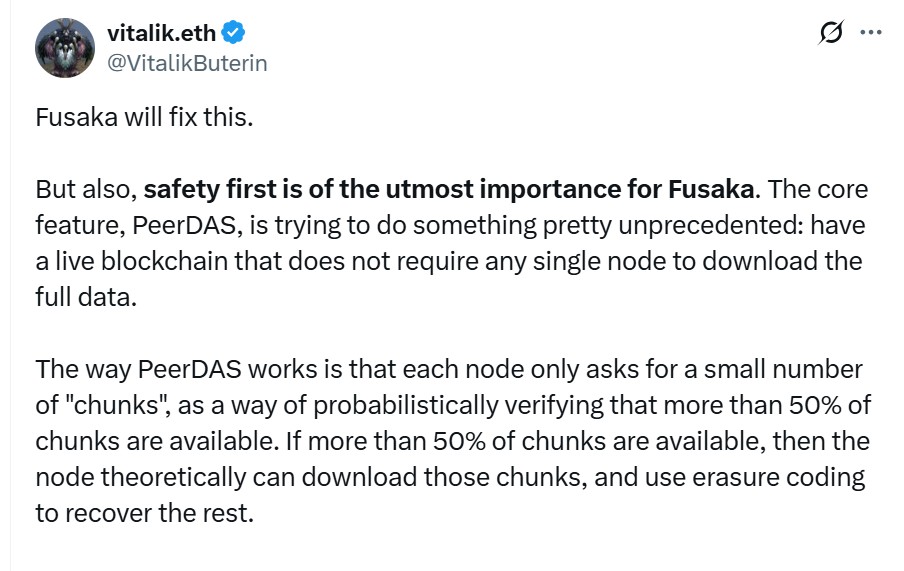Fusaka PeerDAS: Vitalik Buterin Explains Ethereum’s Next Big Upgrade
Today Ethereum co-founder Vitalik Buterin posted about the upcoming upgrade and its central feature. Vitalik said Fusaka PeerDAS will let nodes check pieces of block data instead of downloading everything, which helps scale Layer-2s and, later, Layer-1. This note pushed fresh attention to Fusaka and to testing plans from core devs.
Vitalik Says, Fusaka’s PeerDAS Brings Data Availability Scaling to Ethereum
Vitalik’s main message: safety first, and PeerDAS is the key part of new update that makes data availability cheaper and easier. He explained that nodes will sample small “chunks” of information to prove a block is available.
If enough chunks are found, nodes can reconstruct the whole block with erasure coding. That means ordinary nodes use less bandwidth and storage, and rollups can post more data cheaply. In practice, Vitalik’s comment means the team will move carefully, increasing blob capacity slowly while testing because the idea is new and must be safe.

Source : X
Why Fusaka PeerDAS is trending today
This came out now because it is near mainnet planning in the roadmap and teams are finishing tests. Public threads from core devs and a visible note from Vitalik act like a flag for the media and builders to report as they hit it fast. Also, many projects that run on Layer-2s want the capacity gains it promises, so any comment sparks attention across social and news outlets.
What “Fusaka Will Fix This” Really Means For Users
When Vitalik says “Fusaka will fix this,” the update aims to lower fees and let rollups publish lots more data without making every node store that data. For users, that should mean lower Layer-2 fees and smoother apps — but only after careful testing and staged increases in blob limits.
How PeerDAS works
This means each node asks a few peers for random chunks of a block. If more than half the chunks are available, nodes can trust the block and use erasure coding to rebuild missing pieces. This lowers storage and bandwidth needs for normal nodes and lets the chain accept many more data “blobs” per block over time.
Reactions Across The Ecosystem
• Developers: See as an elegant technical tool, but they want long tests and audits.
• Rollup teams: They welcome more blob capacity because calldata costs fall.
• Node operators: Lighter storage and bandwidth is good, but they will watch security metrics before upgrading.
• Everyday users: Benefits may take months; expect gradual improvements, not instant miracles.
Past Upgrades That Led Here
The new update follows earlier upgrades like Pectra and a long roadmap to scale Ethereum. Over months, researchers proposed PeerDAS (EIP-7594) and testnets started to try sampling. Vitalik’s post ties these past steps to today’s planning and signals to the community that the idea now has high-level support with safety warnings attached.
Final Thoughts
Vitalik’s post is a cautious green light: this new version could unlock much more cheap capacity for Layer-2s, but developers must raise blob counts slowly and test hard. If tests pass, Fusaka PeerDAS may change how Ethereum scales; if not, the team will slow the rollout. Either way, this is an important moment for the network.
免责声明:本文章仅代表作者个人观点,不代表本平台的立场和观点。本文章仅供信息分享,不构成对任何人的任何投资建议。用户与作者之间的任何争议,与本平台无关。如网页中刊载的文章或图片涉及侵权,请提供相关的权利证明和身份证明发送邮件到support@aicoin.com,本平台相关工作人员将会进行核查。




